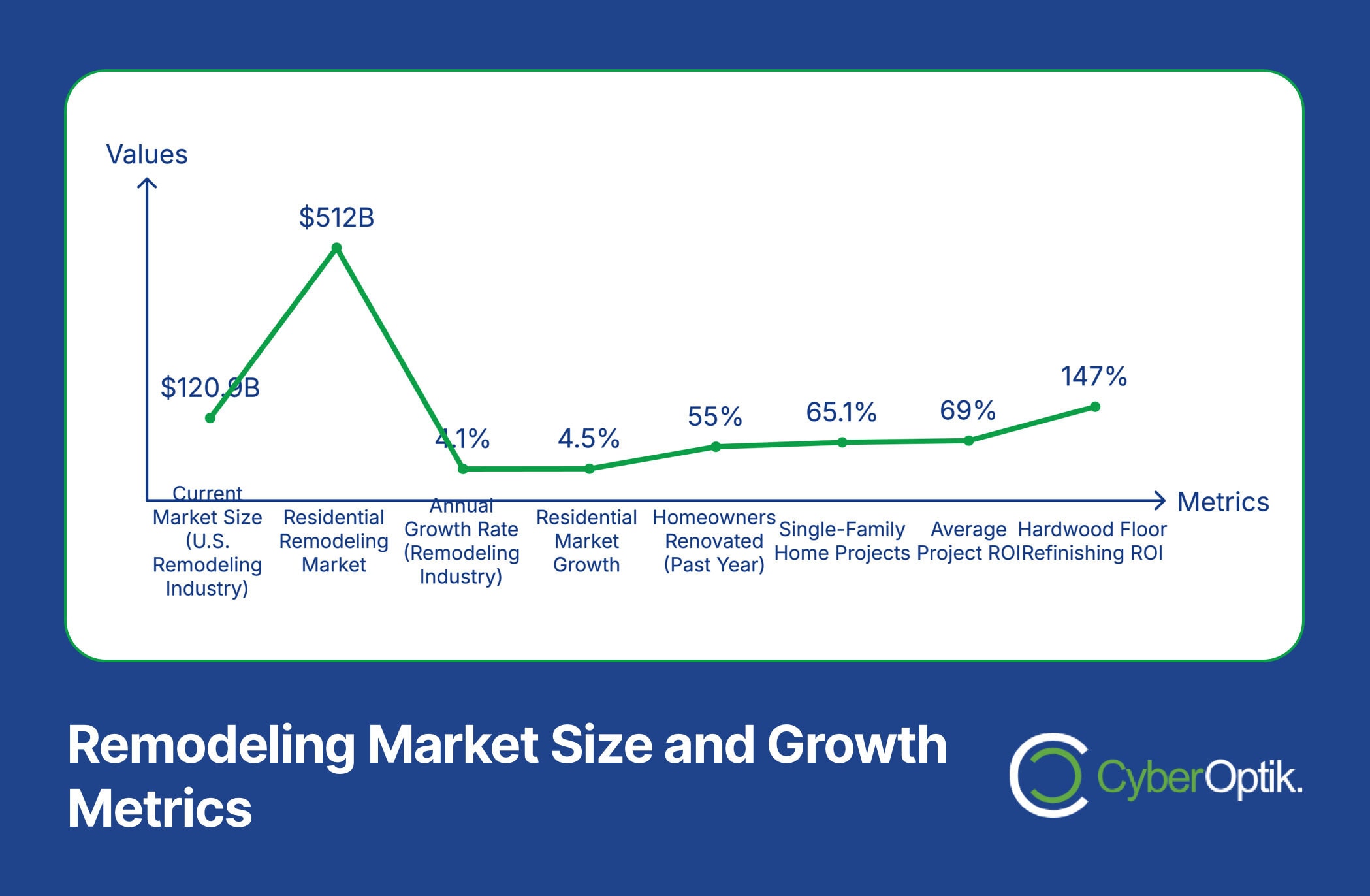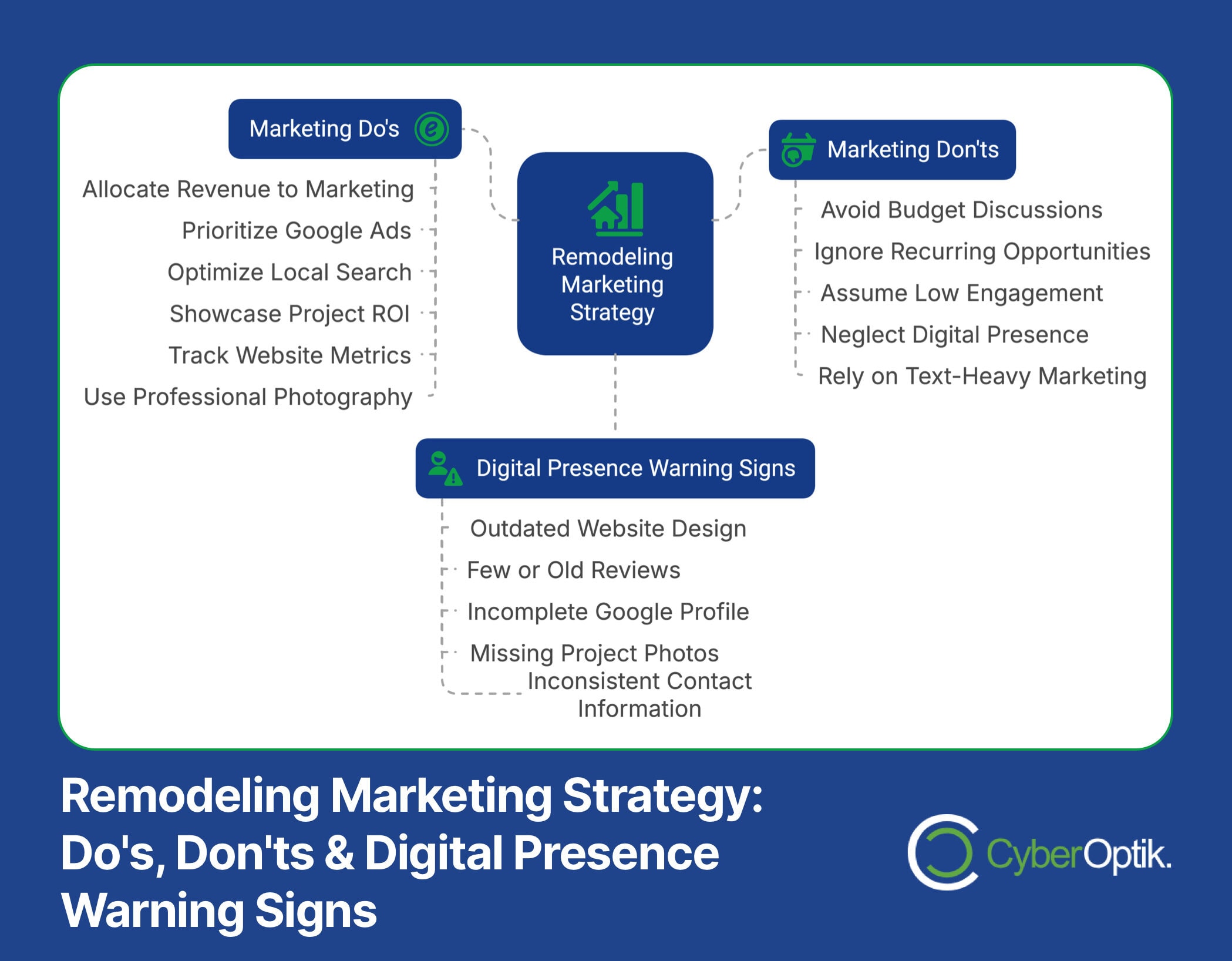In the remodeling industry, quality craftsmanship alone doesn’t guarantee business success. Effective marketing makes the critical difference between struggling contractors and thriving renovation businesses. We’ve seen firsthand how the right marketing approach can transform a remodeling company’s growth trajectory.
This comprehensive guide explores the essential do’s and don’ts of remodeling marketing. Based on industry data and proven strategies, we’ll show you exactly what works and what doesn’t when marketing your remodeling services. These actionable insights will help you generate more qualified leads while optimizing your marketing budget.
Whether you’re just starting your remodeling business or looking to improve your existing marketing efforts, these principles apply across kitchen renovations, bathroom remodels, or full home makeovers. Let’s examine the strategies that drive sustainable growth for remodeling contractors.
Understanding the Remodeling Market Landscape
Before diving into specific tactics, you need to understand the current market environment. The remodeling industry continues to show remarkable resilience and growth potential despite economic fluctuations.
Current Market Size and Growth Projections

The remodeling sector represents a substantial economic opportunity. The U.S. remodeling industry is valued at $120.9 billion in 2024. (Source: IBISWorld)
This robust market is expected to continue expanding at a healthy rate. Industry projections show an expected 4.1% annual growth through 2027. (Source: Better Business Bureau)
The following table illustrates key statistics about the current remodeling market:
| Market Indicator | Current Value | Growth Trend |
|---|---|---|
| U.S. Remodeling Industry Size | $120.9 billion | Growing |
| Annual Growth Rate | 4.1% | Steady |
| Residential Remodeling Market | $512 billion | 4.5% annual growth |
| Average Project ROI | 69% | Varies by project type |
These figures highlight the significant opportunity available to remodeling businesses with effective marketing strategies.
Key Consumer Trends in Home Remodeling
Understanding homeowner motivations helps shape your marketing message. Single-family homes represent the largest segment of the market, with 65.1% of remodeling projects involving single-family detached homes. (Source: Better Business Bureau)
Homeowner engagement with remodeling remains consistently high. Data shows that 55% of homeowners renovated part of their home in the past year. (Source: WebFX)
What motivates these homeowners to undertake remodeling projects? Research from home improvement industry trends indicates several key drivers:
- Functionality improvements – Making spaces more usable for current needs
- Energy efficiency upgrades – Reducing utility costs while improving comfort
- Modernization – Updating outdated fixtures, finishes and layouts
- Home value enhancement – Improving resale potential
- Lifestyle adaptation – Accommodating changing family needs
Aligning your marketing messaging with these motivations creates stronger connections with potential clients.
The Digital Transformation of Remodeling Marketing
The remodeling industry has undergone significant digital transformation in recent years. Traditional word-of-mouth remains important but digital channels now dominate the customer journey.
Today’s homeowners conduct extensive online research before contacting remodeling companies. They browse portfolios, read reviews, and compare options online. This behavioral shift requires remodelers to establish strong digital presence across multiple platforms.
The home services industry has seen a dramatic shift toward digital-first marketing approaches. Mobile searches for home service professionals have grown significantly year over year, with 93% of consumers using online searches when looking for local home service businesses. (Source: Invoca)
Essential Do’s for Remodeling Marketing Success
Now let’s explore the key strategies that successful remodeling companies implement in their marketing efforts.

Highlight Market Growth and Opportunity
Smart remodelers communicate industry growth in their marketing materials. Sharing market statistics builds consumer confidence in remodeling decisions.
When marketing to potential clients, emphasize the robust nature of the remodeling industry. Highlighting that the residential remodeling market reached $512 billion in 2022 and continues growing at 4.5% annually demonstrates that renovating remains a sound investment decision. (Source: WebFX)
This growth-focused messaging positions your company as part of a thriving industry rather than a risky expense. Consumers feel more confident choosing remodeling when they understand its mainstream popularity.
Showcase Project Momentum and Follow-up Potential
Successful remodelers market the “gateway project” concept effectively. Initial projects often lead to additional work when handled properly.
Marketing materials should highlight the natural progression of remodeling projects. Research shows that 86% of homeowners renovate additional areas after completing one project, indicating the significant opportunity for ongoing client relationships. (Source: WebFX)
This statistic offers two key marketing advantages. First, it helps justify investment in customer acquisition. Second, it emphasizes the importance of excellent service delivery throughout the initial project.
Demonstrate Return on Investment Clearly
Effective remodeling marketing addresses ROI concerns directly. Homeowners want to know their renovation dollars will maintain or increase property value.
Use clear data in your marketing to demonstrate remodeling value. The average remodeling project yields a 69% return on investment at resale, making it a financially sound choice for many homeowners. (Source: WebFX)
Some projects deliver even more impressive returns. Refinishing hardwood floors recovers 147% of costs at resale, making it one of the most financially advantageous upgrades homeowners can make. (Source: National Association of Realtors)
The following table shows ROI comparisons for popular remodeling projects:
| Remodeling Project | Average Cost | ROI at Resale |
|---|---|---|
| Hardwood Floor Refinishing | $3,400 | 147% |
| New Wood Flooring | $5,500 | 118% |
| HVAC Replacement | $8,200 | 85% |
| Kitchen Renovation | $80,000 | 75% |
| Bathroom Renovation | $35,000 | 71% |
Incorporating this information into your marketing helps homeowners justify their remodeling investments.
Allocate Marketing Budget Strategically
Budget allocation makes or breaks remodeling marketing success. Small contractors often underspend on marketing, limiting growth potential.
Industry benchmarks provide clear guidance on marketing investment levels. Successful remodeling companies typically allocate 5-6% of their total revenue to marketing activities, including digital campaigns, events, and other promotional efforts. (Source: Journal of Light Construction)
This consistent investment enables steady lead generation rather than the feast-or-famine cycle that plagues many remodeling businesses. Strategic budget allocation should span multiple channels while emphasizing those with highest returns.
Prioritize Google Ads Over Yelp Advertising
Digital advertising platform selection significantly impacts marketing ROI. Not all platforms deliver equal value for remodeling companies.
Data shows dramatic cost differences between popular advertising platforms. Remodeling companies pay approximately $200 per lead with Google Ads compared to $2,000 per lead through Yelp advertising. (Source: Craftsmanship Marketing)
This tenfold difference in lead acquisition cost should inform your advertising strategy. While maintaining a strong Yelp presence remains important for reviews and credibility, directing your paid advertising budget toward effective Google Ads strategies typically yields superior returns.
The table below compares key advertising platforms for remodelers:
| Advertising Platform | Average Cost Per Lead | Targeting Capabilities | Best For |
|---|---|---|---|
| Google Ads | $200 | High (Keywords, Location, Intent) | Active searchers with immediate needs |
| Facebook Ads | $300-500 | High (Demographics, Interests, Behaviors) | Awareness and inspiration-stage prospects |
| Yelp Ads | $2,000 | Medium (Category, Location) | Brand visibility to platform users |
| Local Service Ads | $350-450 | Medium (Service Type, Location) | Credibility-focused lead generation |
This data helps prioritize your advertising spend for maximum impact.
Optimize for Local Search Engine Visibility
Local search visibility directly impacts lead generation for remodelers. Appearing in local search results drives high-intent traffic to your business.
Local SEO should be a cornerstone of your digital strategy. Research confirms that 77% of consumers use search engines to find local remodeling services when planning renovation projects. (Source: Journal of Light Construction)
This consumer behavior makes local search optimization essential for remodeling companies. Several tactical approaches can improve your local visibility:
- Google Business Profile optimization – Complete all sections with accurate information
- Location-specific website content – Create pages for each service area
- Local citation building – Ensure consistent NAP (Name, Address, Phone) across directories
- Review generation – Actively solicit customer reviews to improve rankings
- Location-specific keywords – Incorporate geographic terms in website content
Implementing these tactics helps ensure your remodeling business appears when local homeowners search for renovation services. Studies consistently show that online reviews significantly impact your local search rankings and consumer trust.
Track Website Traffic and Conversion Metrics
Data-driven marketing decisions require consistent tracking. Many remodelers fail to monitor key performance indicators.
Setting appropriate traffic goals helps measure marketing effectiveness. Industry benchmarks suggest smaller remodeling companies (under $1M revenue) should aim for at least 1,000 monthly website visits to generate sufficient leads. (Source: Journal of Light Construction)
Beyond raw traffic numbers, successful remodelers track conversion rates at each funnel stage. This measurement helps identify optimization opportunities throughout the customer journey from awareness to signing a contract.
Strategic Website Optimization
Looking for a more comprehensive approach to contractor website design? Discover our complete guide to creating contractor websites that generate leads and convert visitors into customers.
Critical Don’ts That Hinder Remodeling Marketing
Now, let’s examine common mistakes that undermine remodeling marketing effectiveness. Avoiding these pitfalls saves marketing dollars and improves results.
Don’t Underestimate Budget Discussions
Transparent budget conversations prevent client disappointment. Many remodelers avoid direct cost discussions, creating problems later.
Budget overruns represent a major source of client dissatisfaction. Research indicates that 80% of homeowners exceed their initial remodeling budgets by at least $500 during renovation projects. (Source: WebFX)
Addressing this reality preemptively in your marketing and sales process sets appropriate expectations. Clients appreciate honest discussions about potential cost variables rather than unrealistic projections that lead to disappointment.
Marketing materials should emphasize value, quality, and realistic cost expectations rather than focusing solely on being the lowest bidder. This approach attracts clients who prioritize results over finding the cheapest option.
Don’t Ignore Recurring Service Opportunities
Overlooking ongoing service potential leaves money on the table. Smart remodelers build marketing systems that nurture long-term client relationships.
The data supports focusing on relationship-building with past clients. Around 80% of U.S. households require handyman services annually, creating natural follow-up opportunities after major renovations. (Source: WebFX)
Creating marketing programs that maintain contact with previous customers yields ongoing revenue opportunities. Email newsletters, seasonal maintenance reminders, and special offers for past clients all help capture this recurring business potential.
Don’t Assume Low Market Engagement
Market participation remains consistently high despite economic fluctuations. Remodelers should maintain aggressive marketing even during perceived slowdowns.
Homeowner renovation activity continues at impressive levels. Statistics show that 55% of homeowners renovated part of their home in the past year, demonstrating robust ongoing demand. (Source: WebFX)
This high engagement level means potential clients are actively looking for remodeling services year-round. Maintaining consistent marketing presence ensures you capture your share of this steady demand rather than mistakenly pulling back during periods of perceived slowdown.
Don’t Neglect Your Digital Presence
Online visibility has become essential for remodeling businesses. Companies without strong digital presence struggle increasingly to compete.
A neglected digital presence sends negative signals to potential clients. Warning signs that your digital marketing needs immediate attention include:
- Outdated website design – Creates perception of an outdated business
- Few or old online reviews – Suggests potential service issues
- Incomplete Google Business Profile – Reduces local search visibility
- No project photos or portfolio – Fails to demonstrate capabilities
- Missing or inconsistent contact information – Creates frustration for prospects
Each of these issues presents significant barriers to attracting new clients in today’s digital-first marketplace. Regular digital presence audits help identify and address these problems before they impact lead generation.
Don’t Overlook the Power of Visual Content
Visual documentation dramatically impacts remodeling marketing effectiveness. Text-heavy marketing fails to showcase the visual transformation that remodeling delivers.
High-quality project photography drives engagement across all marketing channels. The data on visual content engagement is clear – home improvement content with professional photography receives 94% more views than similar content without quality images. (Source: Statista)
Before-and-after photos provide the most compelling visual evidence of your capabilities. Investing in professional photography for completed projects yields marketing assets that continue generating returns across your website, social media, and advertising materials.
Building an Effective Digital Marketing Strategy for Remodelers
With the key do’s and don’ts established, let’s examine how to implement a cohesive digital marketing strategy for your remodeling business.
Creating a Conversion-Focused Website
Your website serves as the foundation of your digital marketing efforts. It must balance visual appeal with functional lead generation capabilities.
The most effective remodeling websites include several critical elements:
- Compelling project galleries – Showcasing your best work with high-quality photos
- Clear service descriptions – Detailing your specialties and service areas
- Prominent contact information – Making it easy to reach you
- Trust indicators – Including licenses, certifications, and associations
- Testimonials and reviews – Providing social proof from satisfied clients
Beyond these basics, your website should implement strategic calls-to-action throughout the user journey. How can contractors create websites that generate leads? The answer lies in thoughtful user experience design that guides visitors toward conversion points.
Implementing Local SEO Tactics
Local search optimization directly impacts lead volume for remodeling businesses. Strategic implementation of local SEO best practices improves visibility to nearby homeowners.
Local search performance depends on several ranking factors:
| Local SEO Factor | Impact Level | Implementation Complexity |
|---|---|---|
| Google Business Profile Optimization | Very High | Low |
| Local Citation Consistency | High | Medium |
| Review Quantity and Quality | Very High | Medium |
| On-page Location Signals | Medium | Medium |
| Localized Content Creation | High | High |
Focusing on these factors improves your visibility for location-based searches like “bathroom remodeler near me” or “kitchen renovation [city name].” These high-intent searches often represent homeowners who are ready to hire, making them especially valuable.
Leveraging Social Proof and Testimonials
Consumer trust significantly impacts remodeling lead conversion rates. Effective use of social proof overcomes natural skepticism about contractor reliability.
Strategic use of client testimonials builds confidence in your services. The data on consumer behavior shows that 92% of people hesitate to make a purchase if there are no customer reviews, and positive reviews make 73% of consumers trust a business more. (Source: Ruby Home)
Beyond basic testimonials, consider implementing more advanced social proof elements. Video testimonials from satisfied clients create powerful credibility. Before/after project slideshows with client commentary demonstrate real results. Case studies detailing project challenges and solutions showcase your problem-solving abilities.
Utilizing Email Marketing for Project Updates
Email remains a highly effective channel for remodeling marketers. Strategic email programs nurture leads and maintain client relationships.
Email marketing serves multiple functions in remodeling business development. It nurtures prospects who aren’t ready to commit immediately. It provides project updates to active clients. It maintains relationships with past clients for referrals. It showcases recently completed projects to your audience.
The effectiveness of email marketing depends on capturing the right information at the inquiry stage. Beyond basic contact details, collect information about project timelines, budgets, and specific renovation areas for more targeted follow-up.
Marketing Blueprint for Contractors
Want a comprehensive marketing system for your remodeling business? Check out our blueprint for effective contractor marketing that can be adapted to any home service business.
Measuring Success: Key Metrics for Remodeling Marketers
Effective marketing measurement guides ongoing optimization. Tracking the right metrics helps remodeling companies improve results over time.
Lead Generation Metrics That Matter
Lead volume alone provides insufficient information. Smart remodelers track multiple lead quality indicators.
When evaluating lead generation performance, focus on these key metrics:
| Lead Metric | What It Measures | Target Value |
|---|---|---|
| Lead Volume | Total number of inquiries | Consistent month-over-month growth |
| Lead Source Distribution | Where leads originate | Diversified across 3+ channels |
| Lead-to-Appointment Ratio | Inquiry quality | 50%+ for qualified leads |
| Appointment-to-Sale Conversion | Sales effectiveness | 25-35% for most remodelers |
| Average Project Value | Revenue per conversion | Consistent with business model |
Tracking these metrics helps identify which marketing channels deliver not just the most leads, but the highest quality leads for your specific business model.
Website Performance Indicators
Website analytics reveal marketing effectiveness and user experience issues. Key metrics help identify improvement opportunities.
Data tracking helps optimize website performance for lead generation. Analytics specialists recommend remodelers focus on several crucial website metrics to evaluate performance, including traffic sources, pageviews per session, and average session duration. (Source: Padula Media)
Monitoring these metrics over time helps identify both problems and opportunities. For example, high traffic but low conversion rates suggest a website engagement issue, while high engagement but low traffic points to marketing reach problems.
Return on Marketing Investment Calculations
ROMI (Return on Marketing Investment) calculations provide clarity on campaign effectiveness. Simple formulas help remodelers evaluate marketing performance.
The basic ROMI formula for remodeling businesses is:
ROMI = (Revenue Generated from Marketing – Marketing Cost) / Marketing Cost * 100%
For example, if you spent $5,000 on marketing that generated $30,000 in project revenue:
ROMI = ($30,000 – $5,000) / $5,000 * 100% = 500%
This calculation becomes more accurate when you factor in average project profit margin, customer acquisition costs, and lifetime value of clients. Regular ROMI analysis helps shift marketing dollars toward the highest-performing channels.
Customer Acquisition Cost Considerations
CAC (Customer Acquisition Cost) directly impacts profitability. Remodelers must balance acquisition costs against project value.
The remodeling industry presents unique CAC challenges due to high project values and low purchase frequency. Unlike recurring service businesses, remodelers typically work with each client on discrete projects with significant gaps between engagements.
Successful branding strategies for remodeling businesses can help reduce acquisition costs by increasing referral rates and enhancing perceived value. Strong branding also improves close rates through better credibility signals and extends customer lifetime value.
Implementing Your Remodeling Marketing Plan
Effective remodeling marketing combines industry best practices with your company’s unique strengths. The do’s and don’ts we’ve explored provide a framework for building a marketing system that generates consistent leads.
Start by analyzing your current marketing performance against the benchmarks we’ve discussed. Identify gaps in your approach and prioritize improvements based on potential impact. Focus first on foundational elements like your website and local SEO before advancing to more complex marketing tactics.
Remember that consistency matters more than perfection. Implementing a sustainable marketing system that you can maintain over time will outperform sporadic marketing efforts, even if those occasional campaigns are more elaborate.
We help remodeling businesses develop and implement effective digital marketing strategies that drive leads and growth. Contact us to discuss how we can assist with your website, SEO, content marketing, or paid advertising needs.




